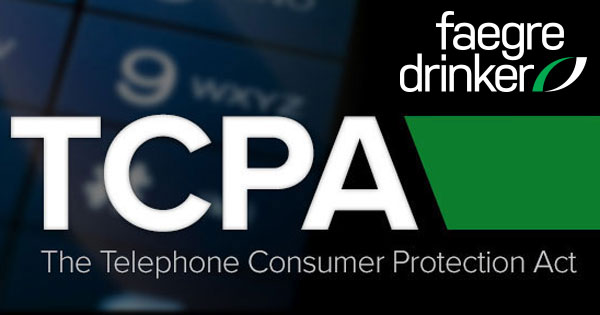A judge in the U.S. District Court for the Eastern District of Pennsylvania recently concluded that receipt of unwanted text messages in violation of the TCPA can constitute an injury-in-fact for purposes of Article III standing, but nevertheless dismissed the claim (without prejudice) pursuant to Rule 12(b)(6) based on its threadbare allegations.
In Camunas v. National Republican Senatorial Committee, the plaintiff (Rolando Camunas) alleged that he received no less than six unsolicited text messages from the defendant (NRSC) asking him to donate to a political party. Civil Action No. 21-1005, 2021 WL 2144671, at *1 (E.D. Pa. May 26, 2021). In his complaint, Camunas described the messages as “generic and obviously pre-written” and alleged that they were sent using an automatic telephone dialing system (ATDS), in violation of the TCPA. Id.
NRSC moved to dismiss the claim for lack of subject-matter jurisdiction, arguing that the complaint failed to establish a concrete injury-in-fact as needed for standing. Id. at *2. In support of its argument, NRSC relied upon the Eleventh Circuit’s decision in Salcedo v. Hanna, which held that receipt of a single text message does not satisfy the injury-in-fact requirement for standing. Id. (citing 936 F.3d 1162, 1169 (11th Cir. 2019)).
But as the Court noted, several circuits have concluded otherwise. In Melito v. Experian Marketing Solutions, Inc., for example, the Second Circuit held that the plaintiffs’ “receipt of the unsolicited text messages, sans any other injury, is sufficient to demonstrate injury-in-fact” for purposes of Article III. Id. (quoting 923 F.3d 85, 88 (2d Cir. 2019)).
While the Third Circuit has yet to weigh in on the issue, it addressed a similar question in Susinno v. Work Out World, Inc., where it held that receipt of a single robocall may confer standing. Id. at *3 (citing 862 F.3d 346, 348 (3d Cir. 2017)). After Susinno was handed down, the District of New Jersey held in Zelma v. Penn LLC that a plaintiff who allegedly received six unsolicited texts from an ATDS had standing to pursue a TCPA claim. Id. (citing No. 19-8725, 2020 WL 278763, at *6 (D.N.J. Jan. 17, 2020)).
Based on the similarities between his allegations and those in Zelma and Susinno, the Court concluded that Camunas established an injury-in-fact and denied NRSC’s motion to dismiss for lack of subject-matter jurisdiction. Id. at *4. Camunas’s victory was short-lived, however: the Court then dismissed the complaint for failure to state a claim.
First, the Court held that the plaintiff alleged no facts establishing that NRSC (rather than some other entity) was the sender of the messages. Id. The Court noted that the complaint provided neither the content of the messages nor the phone number from which the messages were sent—two pieces of factual information which could create a plausible link between the content and the NRSC (without which the assertion of NRSC’s liability was just a conclusory allegation). Id. This shortcoming undermined both his claim under § 227(b) (call made using an ATDS to a cellular device without consent) and his claim under § 227(c) (call made to a number on the DNC list). Id. at *4, *6. The Court expressly declined to reach the issue of whether § 227(c) applied to political calls. Id. at *6 n.5.
Second, the Court held that Camunas had not plausibly alleged that the texts were sent using an ATDS. The Court started its analysis by noting that the Supreme Court’s recent decision in Facebook, Inc. v. Duguid clarified that dialing numbers from a stored list alone is not sufficient to render a device an ATDS. See id. at *5. Citing multiple pre-Duguid decisions, however, the Court explained that the existence of an ATDS can still be pled on information and belief, but that such allegations “require additional factual information, such as the absence of a relationship between the parties,” “the random nature of the automation device,” “the nature of the message,” “the length of the sending number” (i.e., that a short code is more suggestive of an ATDS), and the “number of messages.” Id. The Court then held that Camunas had not plausibly alleged the use of an ATDS because he had not (i) identified the specific content of the messages, (ii) identified the phone number from which the messages were sent or indicated whether that number was a short code, or (iii) disclaimed any prior relationship with the NRSC. Id. at *6. The Court also rejected Camunas’s argument that the NRSC’s use of an automated system for consented-to messages meant that the NRSC used that same system to communicate with him. Id.
The Court also deferred ruling on the defendant’s argument that Camunas had pleaded himself out of court. According to the NRSC, Camunas had done so by alleging that the so-called ATDS used by NRSC merely dialed from a stored list of numbers. Id. at *6 n.4. In the Court’s view, however, the allegation that “[u]pon information and belief, Defendant uses dialing technology, which calls phone numbers from a stored list using a random or sequential number generator to select those phone numbers” was ambiguous. Id.

